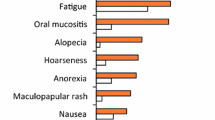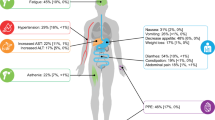Abstract
As newer, molecularly targeted, anticancer drugs are entering clinical practice, a wide array of previously unrecognised and ill defined side effects of these drugs are increasingly observed. Sorafenib and sunitinib are two of these novel agents, acting on tumour angiogenesis as well as on other key proliferative pathways; recently approved for the treatment of advanced kidney cancer, they may cause peculiar cutaneous, vascular and mucosal toxicities, including hand-foot skin reaction, skin rash, hypertension and GERD-like oesophagitis/gastritis. In this review, we shall deal with these poorly recognised, but sometimes extremely distressing, toxicities; pathophysiologic mechanisms will be discussed and suggestions for treatment of each toxicity will be proposed, based on the few pieces of evidence available and, especially, on our empirical experience.
Similar content being viewed by others
References
Ajani J, Allgood V (2004) Molecular mechanisms in cancer: what should clinicians know? Semin Oncol 32[Suppl 8]:2–4
— (2004) Managing patients through aggressive cancer therapies. ONS News 19[Suppl]:33–34
Escudier B, Szczylik C, Eisen T et al (2005) Randomized phase III trial of the Raf kinase and VEGFR inhibitor Sorafenib (BAY 43-9006) in patients with advanced renal cell carcinoma (RCC). Proc Am Assoc Clin Oncol 23:Abs. 4510
Escudier B, Eisen T, Stadler WM et al (2007) Sorafenib in advanced clear-cell renal-cell carcinoma. N Engl J Med 356:125–134
Motzer RJ, Hutson TE, Tomczak P et al (2007) Sunitinib versus interferon alfa in metastatic renal cell carcinoma. N Engl J Med 356:115–124
Demetri GD, Van Oosterom AT, Blackstein M et al (2005) Phase 3, multicenter, randomized, double-blind, placebo-controlled trial of SU11248 in patients (pts) following failure of imatinib for metastatic GIST. Proc Am Assoc Clin Oncol 23:Abs. 4000
Hansen RM (1991) 5-Fluorouracil by protracted venous infusion: a review of recent clinical studies. Cancer Invest 9:637–642
Scheithauer W, Blum J (2004) Coming to grips with hand-foot syndrome. Insights from clinical trials evaluating capecitabine. Oncology (Huntingt) 18:1161–1168
Trotti A, Colevas AD, Setser A et al (2003) CTCAE v3.0: development of a comprehensive grading system for the adverse effects of cancer treatment. Semin Radiat Oncol 13:176–181
Robert C, Soria JC, Spatz A et al (2005) Cutaneous side-effects of kinase inhibitors and blocking antibodies. Lancet Oncol 6:491–500
Serup J (1992) A double-blind comparison of two creams containing urea as the active ingredient. Assessment of efficacy and side-effects by non-invasive techniques and a clinical scoring scheme. Acta Derm Venereol Suppl (Stockh) 177:34–43
Bikowski J (2004) Hyperkeratosis of the heels: treatment with salicylic acid in a novel delivery system. Skinmed 3:350–351
Jacot W, Bessis D, Jorda E et al (2004) Acneiform eruption induced by epidermal growth factor receptor inhibitors in patients with solid tumors. Br J Dermatol 151:238–241
Perez-Soler R (2003) Can rash associated with HER1/EGFR inhibition be used as a marker of treatment outcome? Oncology (Huntingt) 17[Suppl 12]:23–28
Perez-Soler R, Saltz L (2005) Cutaneous adverse effects with HER1/EGFR-targeted agents: is there a silver lining? J Clin Oncol 23:5235–5246
Albanell J, Rojo F, Averbuch S et al (2002) Pharmacodynamic studies of the epidermal growth factor receptor inhibitor ZD1839 in skin from cancer patients: histopathologic and molecular consequences of receptor inhibition. J Clin Oncol 20:110–124
Funding AT, Johansen C, Kragballe K et al (2006) Mitogenand stress-activated protein kinase 1 is activated in lesional psoriatic epidermis and regulates the expression of pro-inflammatory cytokines. J Invest Dermatol 126:1784–1791
Wilgus TA, Matthies AM, Radek KA et al (2005) Novel function for vascular endothelial growth factor receptor-1 on epidermal keratinocytes. Am J Pathol 167:1257–1266
Krakauer T, Buckley M (2003) Doxycycline is anti-inflammatory and inhibits staphylococcal exotoxin-induced cytokines and chemokines. Antimicrob Agents Chemother 47:3630–3633
Amsden GW (2005) Anti-inflammatory effects of macrolides — an underappreciated benefit in the treatment of community-acquired respiratory tract infections and chronic inflammatory pulmonary conditions? J Antimicrob Chemother 55:10–21
Yagi A, Kabash A, Okamura N et al (2002) Antioxidant, free radical scavenging and anti-inflammatory effects of aloesin derivatives in Aloe vera. Planta Med 68:957–960
Reider N, Issa A, Hawranek T et al (2005) Absence of contact sensitization to Aloe vera (L.) Burm. f. Contact Dermatitis 53:332–334
Maddocks-Jennings W, Wilkinson JM, Shillington D (2005) Novel approaches to radiotherapy-induced skin reactions: a literature review. Complement Ther Clin Pract 11:224–231
Moss KG, Toner GC, Cherrington JM et al (2003) Hair depigmentation is a biological readout for pharmacological inhibition of KIT in mice and humans. J Pharmacol Exp Ther 307:476–480
Botchkareva NV, Khlgatian M, Longley BJ et al (2001) SCF/c-kit signaling is required for cyclic regeneration of the hair pigmentation unit. FASEB J 15:645–658
Luo D, Chen H, Searles G, Jimbow K (1995) Coordinated mRNA expression of c-Kit with tyrosinase and TRP-1 in melanin pigmentation of normal and malignant human melanocytes and transient activation of tyrosinase by Kit/SCF-R. Melanoma Res 5:303–309
Feldemen DC, Spencer CGC, Belgore FM et al (2003) Endothelial damage and angiogenesis in hypertensive patients. Relationship to cardiovascular risk factors and risk factor management. Am J Hypertens 16:11–20
Struijker Boudier HAJ, Le Noble JLML, Messing MWJ et al (1992) The microcirculation and hypertension. J Hypertens 10[Suppl 7]:S147–S156
Nakashima H, Suzuki H, Ohtsu H et al (2006) Angiotensin II regulates vascular and endothelial dysfunction: recent topics of Angiotensin II type-1 receptor signaling in the vasculature. Curr Vasc Pharmacol 4:67–78
Veronese ML, Mosenkis A, Flaherty KT et al (2006) 134 Mechanism of hypertension associated with BAY 43-9006. J Clin Oncol 24:1363–1369
Cockcroft J (2004) Nebivolol: a review. Expert Opin Pharmacother 5:893–899
Baatar D, Jones MK, Tsugawa K et al (2002) Esophageal ulceration triggers expression of hypoxia-inducible factor-1α and activates vascular endothelial growth factor gene. Am J Physiol 161:1449–1457
Rafiee P, Ogawa H, Heidemann J et al (2003) Isolation and characterization of human esophageal microvascular endothelial cells: mechanisms of inflammatory activation. Am J Physiol Gastrointest Liver Physiol 285:G1277–1292
Fujiwara Y, Higuchi K, Takashima T et al (2005) Roles of epidermal growth factor and Na+/H+ exchanger-1 in esophageal epithelial defense against acid-induced injury. Am J Physiol Gastrointest Liver Physiol 290;G665–673
Tytgat GN (2002) Review article: treatment of mild and severe cases of GERD. Aliment Pharmacol Ther 16[Suppl 4]:73–78
Moayyedi P, Talley NJ (2006) Gastro-oesophageal reflux disease. Lancet 367:2086–2100
Author information
Authors and Affiliations
Corresponding author
Rights and permissions
About this article
Cite this article
Porta, C., Paglino, C., Imarisio, I. et al. Uncovering Pandora’s vase: the growing problem of new toxicities from novel anticancer agents. The case of sorafenib and sunitinib. Clin. Exper.Med. 7, 127–134 (2007). https://doi.org/10.1007/s10238-007-0145-8
Received:
Accepted:
Published:
Issue Date:
DOI: https://doi.org/10.1007/s10238-007-0145-8




